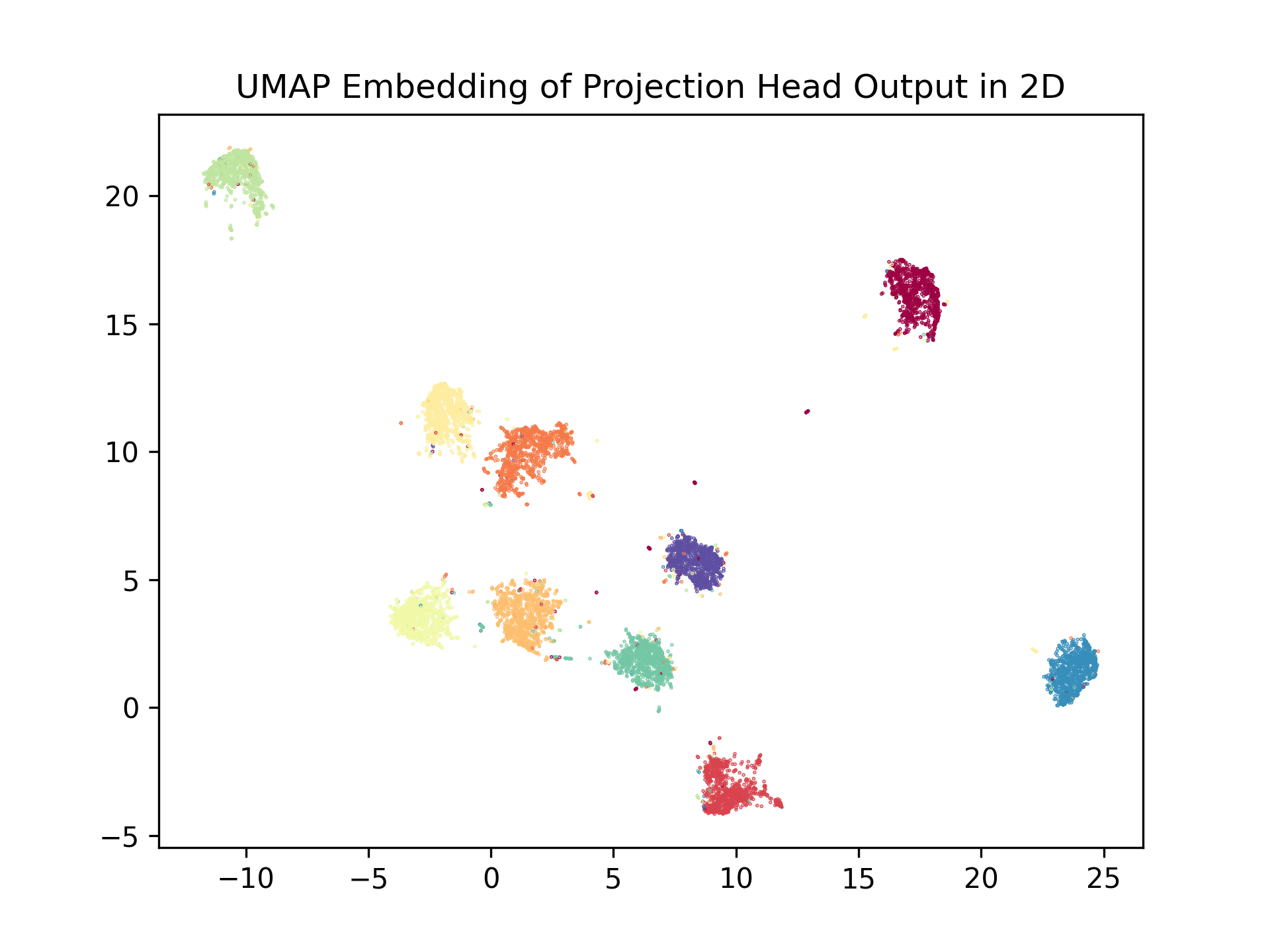A tutorial of implementing/training/fine-tuning the SimCLR model with Pytorch Lightning.
The advantage of using Lightning is to hide miscellaneous details of training configurations such as the automatic mixed precision and distributed data parallel into the Trainer, wrap the model configuration (e.g., optimizers, learning rate schedulers) and step function of training/validating/testing/predicting loops into the LightningModule, and enclose dataset/dataloader setups in LightningDataModules.
Therefore, it allows the users to easier organize and reuse different functionalities in separate modules to decouple them and enables a much cleaner script interface.
Numerous plugins such as meters in torchmetrics are supported to collect batch/step or epoch-level metrics (e.g., loss and AUC) from all devices.
Details are documented in the docstring in codes.
In the example below the scripts are provided to train (self-supervised, with validation of contrastive loss), fine-tune (supervised with a subset of training data), and visualize (via UMAP embedding of projection head outputs of validation set) a resnet-backbone (default Resnet50) on CIFAR10/MNIST (default CIFAR10) dataset.
For support of other models, see simclr_lightning.models.contrast_learning.base.AbstractBaseModel and implement your custom models.
For support of other dataset, see simclr_lightning.dataset.base.AbstractDataset. For dataset in torchvision.datasets other than CIFAR10 and MNIST see simclr_lightning.dataset.example
An example training scripts is provided in simclr_lighting.scripts
At this moment, only Adam optimizer (torch.optim.Adam) is implemented in training and fine-tuning. For larger batch size, e.g., 1024, LARs may be used.
Override the simclr_lightning.models.lightning_modules.base.BaseLightningModule.configure_optimizers to use custom optimizer and learning rate schedulers.
A ModelCheckpoint callback is added to the trainer to monitor the validate_loss field stored in the loggers in training/validation loops defined in LightningModule.
Checkpoints of top-3 models with the lowest validation contrastive loss are automatically exported to disk.
The detailed behavior of how loss is computed and logged/gathered from multiple GPUs can be found in simclr_lightning.models.lightning_modules.simclr_wrapper.SimCLRLightning.
Use the following command to show details of arguments (description omitted in README)
$ python -m simclr_lightning.scripts.train_simclr -h
usage: train_simclr.py [-h] [--export_folder EXPORT_FOLDER] [--data_root DATA_ROOT] [--dataset_name DATASET_NAME] [--out_dim OUT_DIM] [--temperature TEMPERATURE]
[--arch {ResNeXt101_32X8D_Weights,ResNeXt101_64X4D_Weights,ResNeXt50_32X4D_Weights,ResNet,ResNet101_Weights,ResNet152_Weights,ResNet18_Weights,ResNet34_Weights,ResNet50_Weights,Wide_ResNet101_2_Weights,Wide_ResNet50_2_Weights,resnet101,resnet152,resnet18,resnet34,resnet50,resnext101_32x8d,resnext101_64x4d,resnext50_32x4d,wide_resnet101_2,wide_resnet50_2}]
[--n_views N_VIEWS] [--patch_size PATCH_SIZE] [--brightness BRIGHTNESS] [--contrast CONTRAST] [--saturation SATURATION] [--hue HUE] [--blur_prob BLUR_PROB]
[--num_workers NUM_WORKERS] [--num_epochs NUM_EPOCHS] [--batch_size BATCH_SIZE] [--lr LR] [--max_t MAX_T] [--weight_decay WEIGHT_DECAY] [--seed SEED]
[--log_every_n_steps LOG_EVERY_N_STEPS] [--gpu_index GPU_INDEX [GPU_INDEX ...]] [--precision PRECISION]
... omitted
The pretrained model with SimCLR can be fine-tuned with labeled data. Herein we use a portion of the training data (default: 30%) to finetune the pretrained model.
Similar to training, a ModelCheckpointis added to the trainer to monitor the validate_loss for classification of labeled data.
By default, we did not freeze any weights but layers before projection/classification heads can be frozen by set the freeze_weight flag in simclr_lightning.models.lightning_modules.finetune_wrapper.FinetuneLightning.
Details can be found in comments in the example script: simclr_lightning.scripts.finetune_simclr.
Use the following command to show details of arguments (description omitted in README)
$ python -m simclr_lightning.scripts.finetune_simclr -h
usage: finetune_simclr.py [-h] [--simclr_best_model SIMCLR_BEST_MODEL] [--data_root DATA_ROOT] [--export_folder EXPORT_FOLDER] [--dataset_name DATASET_NAME] [--train_sample_ratio TRAIN_SAMPLE_RATIO]
[--arch ARCH] [--out_dim OUT_DIM] [--patch_size PATCH_SIZE] [--brightness BRIGHTNESS] [--contrast CONTRAST] [--saturation SATURATION] [--hue HUE] [--num_workers NUM_WORKERS]
[--num_epochs NUM_EPOCHS] [--batch_size BATCH_SIZE] [--lr LR] [--max_t MAX_T] [--weight_decay WEIGHT_DECAY] [--seed SEED] [--log_every_n_steps LOG_EVERY_N_STEPS]
[--gpu_index GPU_INDEX [GPU_INDEX ...]] [--precision PRECISION]
...omitted
Use the following command to show details of arguments (description omitted in README)
python -m simclr_lightning.scripts.predict_and_visualize -h
usage: predict_and_visualize.py [-h] [--export_folder EXPORT_FOLDER] [--data_root DATA_ROOT] [--simclr_best_model SIMCLR_BEST_MODEL] [--dataset_name DATASET_NAME] [--out_dim OUT_DIM]
[--temperature TEMPERATURE]
[--arch {ResNeXt101_32X8D_Weights,ResNeXt101_64X4D_Weights,ResNeXt50_32X4D_Weights,ResNet,ResNet101_Weights,ResNet152_Weights,ResNet18_Weights,ResNet34_Weights,ResNet50_Weights,Wide_ResNet101_2_Weights,Wide_ResNet50_2_Weights,resnet101,resnet152,resnet18,resnet34,resnet50,resnext101_32x8d,resnext101_64x4d,resnext50_32x4d,wide_resnet101_2,wide_resnet50_2}]
[--patch_size PATCH_SIZE] [--brightness BRIGHTNESS] [--contrast CONTRAST] [--saturation SATURATION] [--hue HUE] [--num_workers NUM_WORKERS] [--num_epochs NUM_EPOCHS]
[--batch_size BATCH_SIZE] [--lr LR] [--max_t MAX_T] [--weight_decay WEIGHT_DECAY] [--seed SEED] [--log_every_n_steps LOG_EVERY_N_STEPS]
[--gpu_index GPU_INDEX [GPU_INDEX ...]] [--precision PRECISION]
We use UMAP to embed the features derived from pretrained model (in the example, before fine-tuning) into 2-D space and observe how the stratification of features in the plots aligned with labels.
Predictions are gathered from multiple GPUs if applicable in a custom callback derived from BasePredictionWriter with custom all_gather function. Note that by default, if distributed data parallel is enabled in multi-gpu training, and if the default torch.utils.data.distributed.DistributedSampler is applied, then each GPU will get a disjoint subset of data from other devices and the results from all devices should be gathered to the full output.
Details are in simclr_lightning.models.callbacks.gather.
By default, we only visualize the output feature of the projection head. To visualize the backbone feature before the projection head, toggle the return_embedding attribute in the model field of simclr_lightning.models.lightning_modules.simclr_wrapper.SimCLRLightning, which is a simclr_lightning.models.contrast_learning.base.AbstractBaseModel object.
The projection head feature of validation data are embedded via UMAP (details in the simclr_lightning.scripts.predict_and_visualize), with the data points colored by their label IDs.
An example of UMAP embedding of pretrained Resnet50-backbone features from CIFAR10 dataset is shown below:

Some codes are derived or inspired from https://theaisummer.com/simclr/, https://github.com/sthalles/SimCLR, and https://github.com/open-mmlab/mmdetection/blob/482f60fe55c364e50e4fc4b50893a25d8cc261b0/mmdet/apis/test.py#L160.